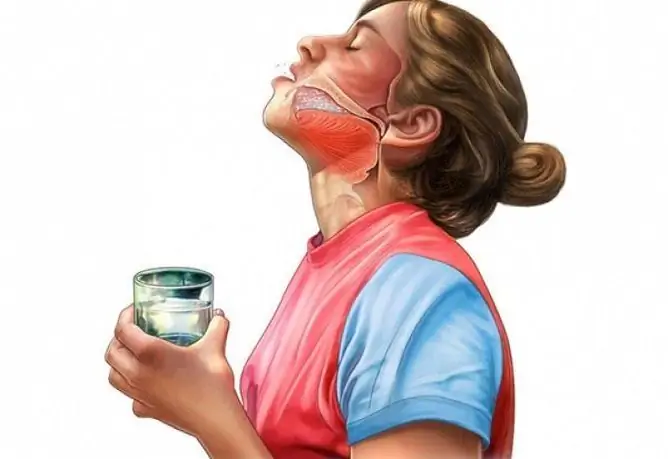- Author Rachel Wainwright [email protected].
- Public 2023-12-15 07:39.
- Last modified 2025-11-02 20:14.
Malaria
General information about the disease

Malaria, also known as swamp fever, is an acute infectious disease that is transmitted by the bite of the Anopheles mosquito. Malaria is widespread in areas with warm and humid climates, where the average annual temperature does not drop below 16 degrees C. In temperate climates, malaria is extremely rare, and no cases of infection have been detected in the circumpolar regions.
When diagnosed with malaria, symptoms indicate central nervous system involvement. Patients have attacks of chills, profuse sweat and high body temperature. If untreated, the disease progresses rapidly and is often fatal. The danger of this infection is evidenced by at least the fact that it is the main cause of death of the working-age population in countries with tropical and subtropical climates.
At the moment, cases of malaria infection are regularly reported in Mexico, the Amazon Valley, in many parts of Africa, on the coast of the Mediterranean and Red Seas, in India and Southeast Asia. In Eastern Europe, the malaria agent was found in Ukraine and the Balkans.
What causes malaria?
Malaria begins to develop due to the activity of the smallest microorganisms - plasmodia. On most continents, there are three species of these parasites - Plasmodium vivax, P. falciparum and P. Malariae. The fourth species, P. Ovale, was found only in Africa, and even then not in all regions. The causative agent of malaria infects not only humans, but also monkeys, reptiles, and birds. The disease is not transmitted from animals to humans, however, isolated cases have been recorded when the infection entered the body of a healthy person through contact with sick monkeys.
How is malaria spread?
Malaria enters the body through the bite of the carrier - the Anopheles mosquito. It damages the skin and injects plasmodium into the blood. Then the parasites move to the liver, infecting red blood cells and vital systems. When an infected person is bitten by a mosquito again, some of the plasmids move into the body of the new host. This is how the complex life cycle of these creatures is repeated.
Malaria - disease symptoms
The characteristic symptoms of malaria are acute attacks of fever. They are observed for several days, after which they are replaced by a febrile period. If treatment for malaria is not carried out or was insufficient, then in the next two to three months, the fever may reappear.
The first symptoms of malaria are found 2-6 weeks after infection. Patients complain about:
- chills;
- headache;
- weakness;
- stool disorders;
- heavy sweating;
- thirsty.
Symptoms of malaria are characterized by cyclical attacks. Chills give way to fever, then the stage of sweating comes, which again gives way to chills. Patients feel cold from 10 minutes to 2-3 hours. During this period, their skin turns pale, becomes covered with roughness and acquires a cyanotic hue. Sometimes malaria is accompanied by severe vomiting and delirium. During the heat, the skin becomes dry and hot. In addition, patients have tachycardia and high body temperature (up to 40 degrees and above). After a few hours, the fever is replaced by sweating and a drop in temperature to normal values. The person's well-being is stabilized, but general weakness remains, which persists until the next wave of attacks.
Malaria treatment

In modern medicine, various drugs are used that can reduce the severity of symptoms or immediately eliminate malaria pathogens. If the correct treatment is prescribed, malaria does not pose a particular danger. The only trouble is that in developing countries it is extremely difficult to obtain qualified medical care, and the patient is often doomed to regular bouts of fever that end in painful death.
Persons who are going to travel to endemic regions are advised to regularly take antimalarial drugs: quinine, mefloquine, chloroquine, acriquine or atabrine. If, nevertheless, the disease has penetrated the body, then it is necessary to stop acute manifestations with the help of hematocides. At the end of the course of treatment, patients are prescribed primaquine, a tissue schizontocide. In cases where malaria is mild, halofantrine, fancidar and mefloquine are the drugs of choice.
Prevention of malaria
All people traveling to the countries of Latin America, Southeast Asia or Africa must undergo a course of chemoprophylaxis of malaria, during which drugs delagil, proguanil and mefloquine are used. Personal non-specific prevention of malaria is also of great importance, including:
- use of repellents;
- installation of special mosquito nets in window and doorways;
- application of electric fumigators
In endemic areas, people should wear as close as possible clothing in light colors. Repellents are applied to the exposed areas of the body. The spread of infection is also prevented by such complex measures as: vector control, timely identification of parasitic carriers, chemoprophylaxis.
YouTube video related to the article:
The information is generalized and provided for informational purposes only. At the first sign of illness, see your doctor. Self-medication is hazardous to health!






